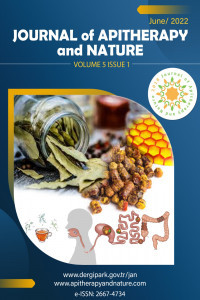Characterized Propolis Extracts, Obtained with Standardized Extraction Method, Show Similar Chemical Profile (HPLC-ESI.MSN) and in vitro Antibacterial, Antioxidant and Anti-inflammatory Activity Through Evaluation of Expression of miRNAS, mRNAS and Proteins
Characterized Propolis Extracts, Obtained with Standardized Extraction Method, Show Similar Chemical Profile (HPLC-ESI.MSN) and in vitro Antibacterial, Antioxidant and Anti-inflammatory Activity Through Evaluation of Expression of miRNAS, mRNAS and Proteins
Propolis, in vitro, Antibacterial, Antioxidant, Anti-inflammatory Activity,
___
- . Galeotti F, Maccari F, Fachini A, Volpi N. (2018) Chemical Composition and Antioxidant Activity of Propolis Prepared in Different Forms and in Different Solvents Useful for Finished Products. Foods. 7(3). 2. Zaccaria V, Curti V, Di Lorenzo A, Baldi A, Maccario C, Sommatis S, Mocchi R, Daglia M. (2017) Effect of Green and Brown Propolis Extracts on the Expression Levels of microRNAs, mRNAs and Proteins, Related to Oxidative Stress and Inflammation. Nutrients 9(10).
- Yayın Aralığı: Yılda 2 Sayı
- Başlangıç: 2018
- Yayıncı: Oktay YILDIZ
Water Extract of Propolis Might be Safer to Use During Pregnancy than Ethanol Extract
Al Mukhlas FIKRI, Ahmad SULAEMAN, Sri Anna MARLIYATI, Mokhamad FAHRUDIN
ARC (Apiceutical Research Centre): Exploring a New Generation of Medicines from the Beehive
İvan MISKULIN, İvana KLARIC, Matija DOMACINOVIC, Berislav PRAKATUR, Mirela PAVIC, Mario RONTA, Maja MISKULIN
María Inmaculada GONZÁLEZ-MARTÍN, Eddy Valentín BETANCES-SALCEDO, Isabel REVILLA, Ana María VIVAR-QUINTANA
North Aegean Greek Islands Propolis Antibacterial-Antifungal Activities against Malassezia
Konstantia GRAIKOU, Aristea VELEGRAKI, Mirto VARSANI, İoanna CHINOU
The Impact of Honeybee Origin on the Quality of Propolis
Gomes da Silva CAHANGO, Soraia I. FALCÃO, Miguel VILAS-BOAS
Isolated Triterpenes from Stingless Bee Lisotrigona furva Propolis in Vietnam
Le Nguyen THANH, Vu Thi Kim OANH, Ha Thi THOA, Diep Thi Lan PHUONG, Nguyen Thi Phuong LIEN, Tran Huu GIAP, Nguyen Thi Minh HANG, Nguyen Van HUNG, Vassya BANKOVA
Preliminary Evaluation of the Cytotoxic Potential of North-West Romanian Propolis
Constantin İ. MATES, Emoke PALL, Marina SPINU, Laura STAN, Mihaela NICULAE
Can Propolis Inhibit Infection Dynamics of Honey Bee (Apis mellifera L.) Viruses in vitro?
Soumaya TOUZANI, Sleman KADAN, Abdalsalam KMAIL, Bashar SAAD, Badiaa LYOUSSI
